What is CMMS Software? A Complete Guide for Maintenance Teams
CMMS software helps businesses centralize maintenance management, reduce downtime, and extend asset life. This guide explains what CMMS is, its key features, benefits, and use cases. You’ll also learn how to choose the right tool for your team and improve efficiency.
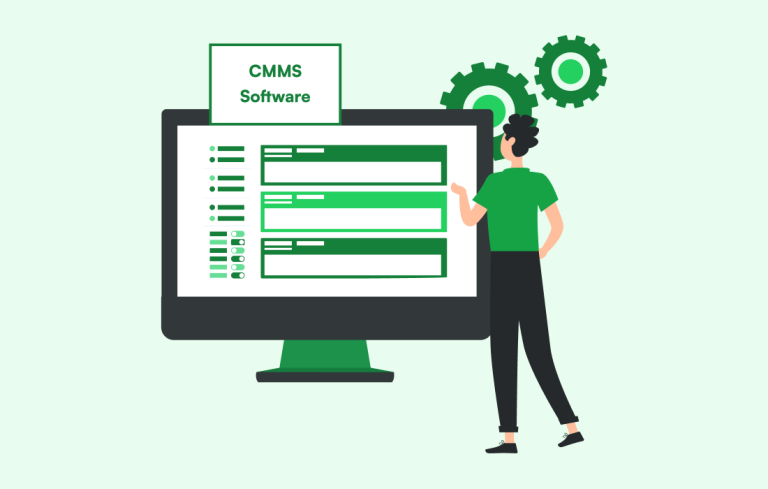
Unplanned downtime is expensive.
Why? Because every hour lost to equipment failure means that you are missing deadlines, wasting labor, and incurring higher costs.
Most teams still manage maintenance with spreadsheets or outdated tools. That works for a while (until operations grow). Then things slip. Work orders get lost. Inspections are missed. Breakdowns increase.
This is where CMMS software comes in. A Computerized Maintenance Management System helps you track assets, schedule preventive maintenance, and keep your team focused on fixing issues before they become problems.
In this guide, we’ll cover:
- What CMMS software is and how it works
- The features that matter most
- Who should use it
- How to pick the right tool for your business
Let’s get started.
Table of Contents
What is CMMS Software?
CMMS = Computerized Maintenance Management System.
It is software that helps teams manage and track maintenance activities in one place.
Without it, maintenance gets messy. Work orders pile up, and there is a chance that spare parts run out at the wrong time. Preventive tasks get skipped, and breakdowns follow.
With a CMMS, everything is centralized. You can:
- Create and assign work orders
- Schedule preventive maintenance
- Track asset history and downtime
- Manage parts and inventory
- Generate reports for compliance and audits
The result? Less unplanned downtime. Lower costs. Longer equipment life.
Quick note: CMMS is not the same as an Enterprise Asset Management system. It covers the full lifecycle of assets, from purchase to disposal. CMMS focuses on keeping assets running reliably.
How Does a CMMS Work?
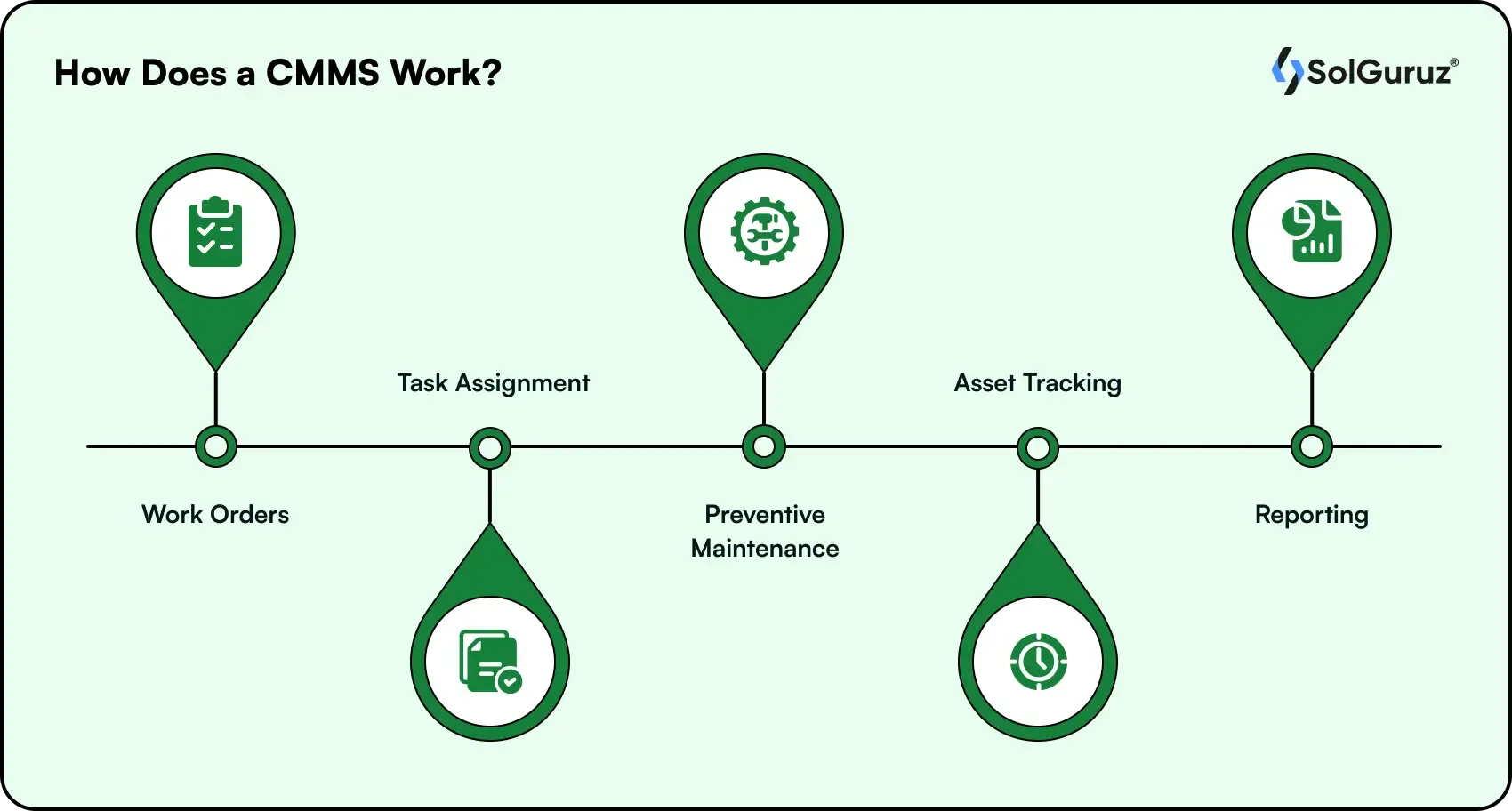
Most maintenance teams run into the same trap: everything lives in different places. A request comes by email. Spare parts are tracked in a spreadsheet. Past repairs are scribbled on paper.
Nothing connects. And that’s why things slip.
A CMMS changes that by centralizing the process. Here’s how it works in practice:
1. Work orders
A machine breaks down. Instead of sending emails or scribbling notes, you log it in the CMMS. If you’re using sensors, the system can even create a work order automatically.
2. Task assignment
The CMMS sends the job to the right technician. They see the problem, priority, and parts needed, all in one place. No confusion. No wasted time.
3. Preventive maintenance
Routine jobs like inspections or oil changes are scheduled automatically. That way, your team fixes things before they fail, not after.
4. Asset tracking
Every job updates the asset history. Over time, you know exactly how often each piece of equipment fails, how much it costs, and when it might need replacing.
5. Reporting
All this data turns into reports. It complies with downtime trends, repair costs, and even technician efficiency. All these insights will help you plan budgets and make smarter decisions.
Pro tip: Many businesses outsource the custom CMMS software development to dedicated companies due to their expertise in that niche.
Key Features of CMMS Software (That Actually Save You Time & Money)
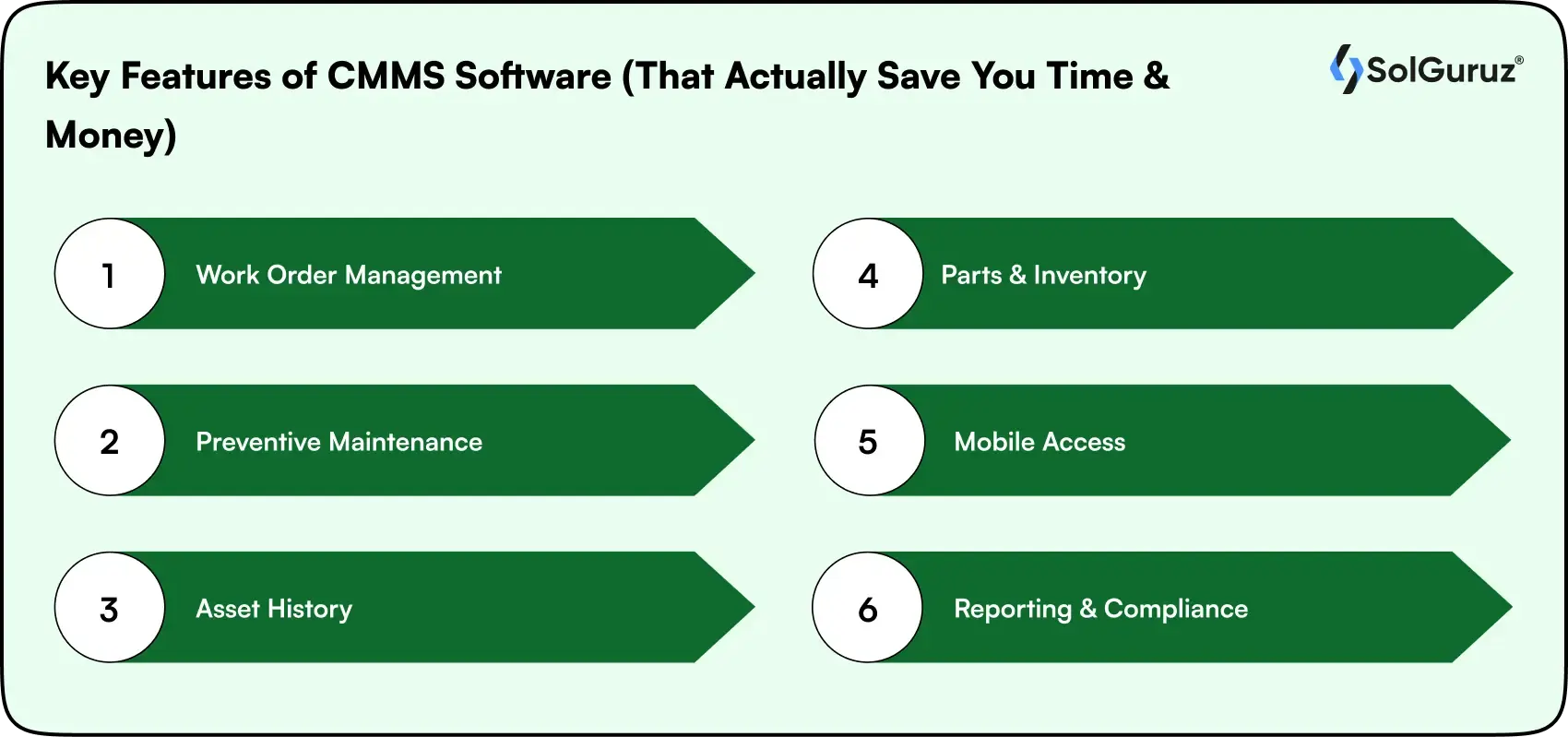
Every CMMS vendor claims to have “powerful features.” The reality? Only a handful of them actually make or break your maintenance operations.
These are the capabilities that separate a tool that collects dust from one that saves you thousands in downtime and repair costs:
-
Work Order Management
This is the core. Every request becomes a digital work order with priority, deadline, and technician assignment. No chasing emails. No guessing who’s doing what.
Value: Keeps your team focused and accountable.
-
Preventive Maintenance
Instead of waiting for machines to fail, you set recurring tasks: inspections, oil changes, filter swaps. The CMMS reminds your team and logs the results.
Value: Downtime drops. Repairs cost less. Assets last longer.
-
Asset History
Every repair and inspection gets tied to the asset. Over time, you will start to see patterns. For example, which machines eat the budget, which ones fail often, and when it’s smarter to replace than repair.
Value: Decisions need to be backed by data, not gut feelings.
-
Parts and Inventory
A CMMS links spare parts to work orders. It tracks what’s used and alerts you before stockouts.
Value: No more delays because a $20 part wasn’t in stock.
-
Mobile Access
Instantaneous updates are what make maintenance proactive. Hence, a mobile CMMS lets technicians update work orders in real-time. Right where the work happens.
Value: Faster responses, better communication, fewer mistakes.
-
Reporting and Compliance
Auditors, managers, regulators, they all want proof. A CMMS generates it instantly: downtime reports, cost breakdowns, safety checks.
Value: Easier compliance, stronger budget justification, zero paperwork headaches.
The Business Impact: Why CMMS Pays for Itself (Benefits Explained)
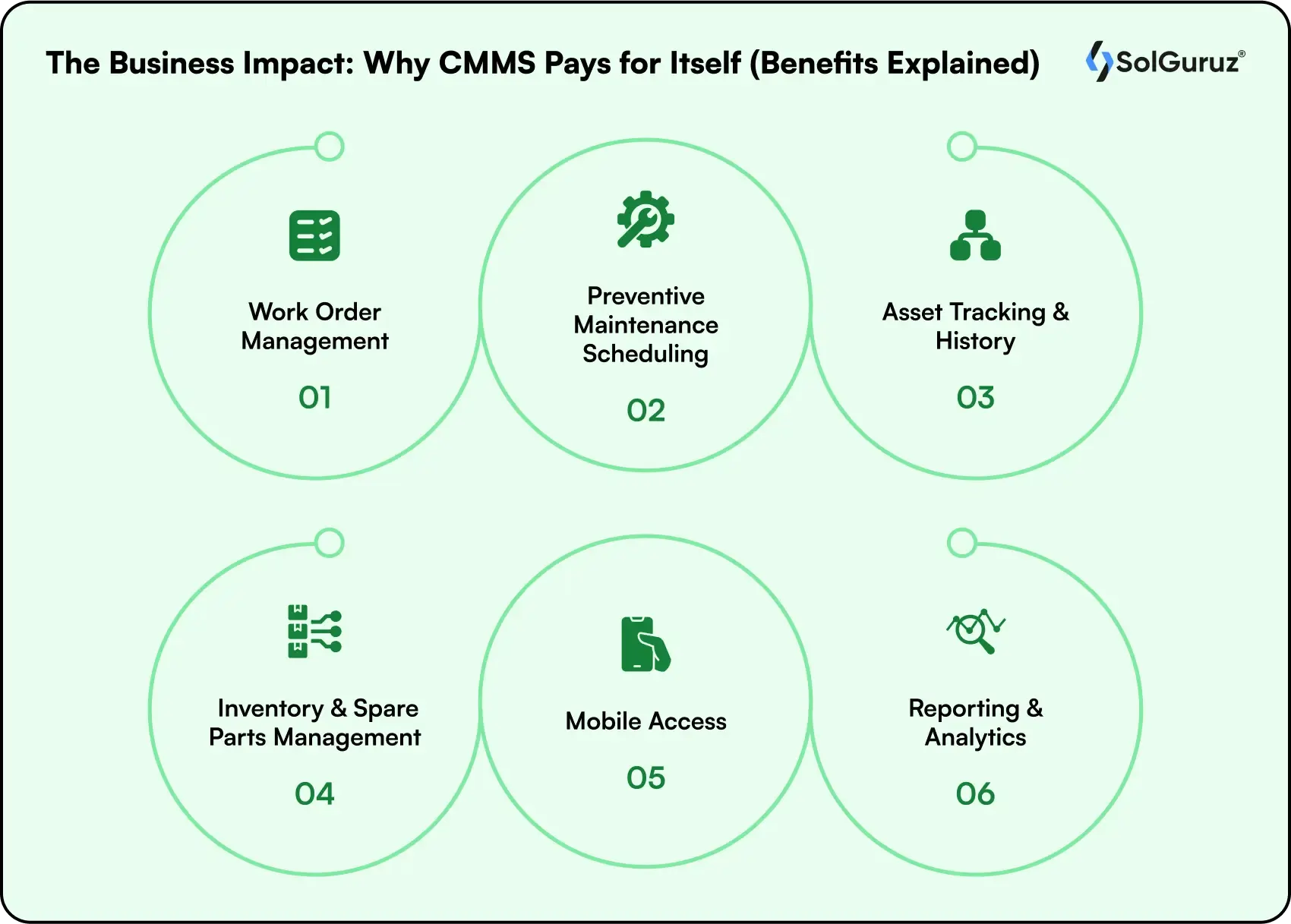
Features are what a CMMS does. Benefits are why you’d actually invest in one. At the end of the day, the question every ops leader asks is simple: Does this system pay for itself? Here’s where the ROI shows up:
1. Work Order Management
A good CMMS helps you keep all the work orders in one place. It will help you In fact, it’s quite simple to assign tasks, set deadlines, and even track progress. That too, without relying on emails or spreadsheets.
2. Preventive Maintenance Scheduling
Preventive maintenance is better than reactive maintenance. Hence, it’s always better that you get a quick alert about the regular inspections or due services.
3. Asset Tracking and History
Every asset has a full service history inside the CMMS. Be it repairs or part replacements, you know exactly what was done when. This makes it easier to spot recurring issues and plan replacements.
4. Inventory and Spare Parts Management
A CMMS links spare parts to the assets that need them. It tracks stock levels and alerts you before you run out, preventing delays during repairs.
5. Mobile Access
With mobile apps, technicians can check work orders, update job status, and upload photos directly from the field. This removes paperwork and keeps records accurate.
6. Reporting and Analytics
A CMMS turns raw maintenance data into insights. You can see downtime trends, maintenance costs, and technician performance and use the data to improve operations.
Who Should Use a CMMS?
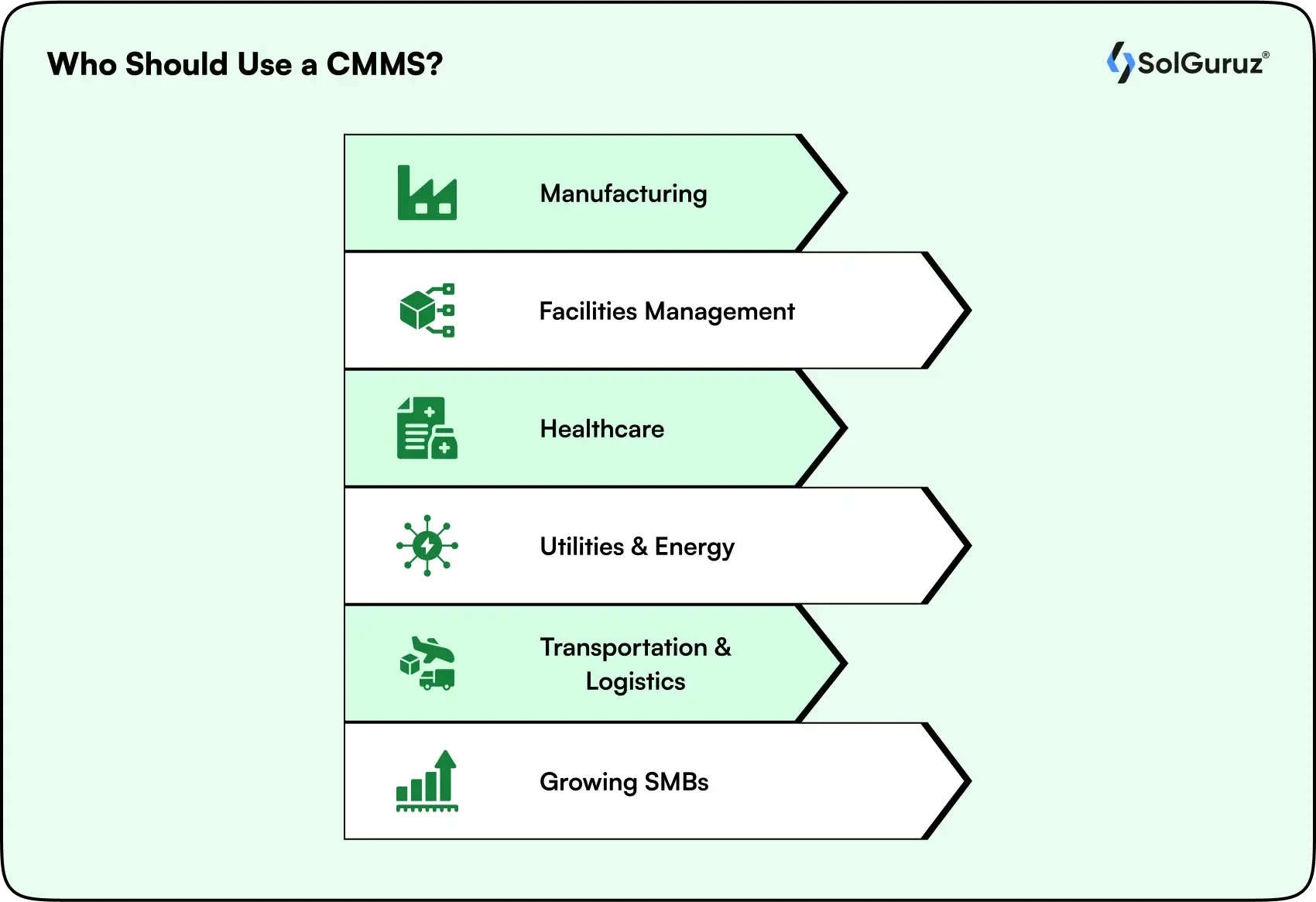
Not every team needs a CMMS on day one. If you’re running a small shop with a handful of machines, spreadsheets may be enough. But as operations grow, manual tracking starts to fail.
Here are the signs you’re ready for a CMMS:
- Frequent unplanned downtime is eating into production or service delivery.
- Work orders are getting lost in emails or paper trails.
- Technicians waste time chasing spare parts or manuals.
- Compliance audits are stressful because records aren’t centralized.
- Maintenance costs keep rising, but you don’t know why.
If these issues sound familiar, it’s time to look at CMMS software.
Also, here are some of the most common places where CMMS software is used:
- Manufacturing
Downtime = Pause in production. Which means that there will be a loss in revenue. A manufacturing CMMS will ensure that you don’t miss out on preventive maintenance (which will help you avoid unplanned downtimes). - Facilities Management
Facility teams face constant maintenance requests. You can keep track of issues, assign tasks, and stay compliant without getting overwhelmed by paperwork. - Healthcare
Medical equipment cannot afford to fail. Hence, the need for a good CMMS increases as it will help you keep the appliances running with scheduled tests. - Utilities & Energy
Power plants, renewable farms, and water facilities have high-value assets that can cause huge damage if they go down. A CMMS prevents costly outages with structured maintenance. - Transportation & Logistics
Missed deliveries mean that your customers will not be satisfied. A CMMS keeps fleets serviced on schedule and reduces unexpected breakdowns. - Growing SMBs
Spreadsheets may work when you’re small. But if work orders are slipping through cracks or audits are stressful, it’s time to move up to a CMMS.
How to Choose the Right CMMS
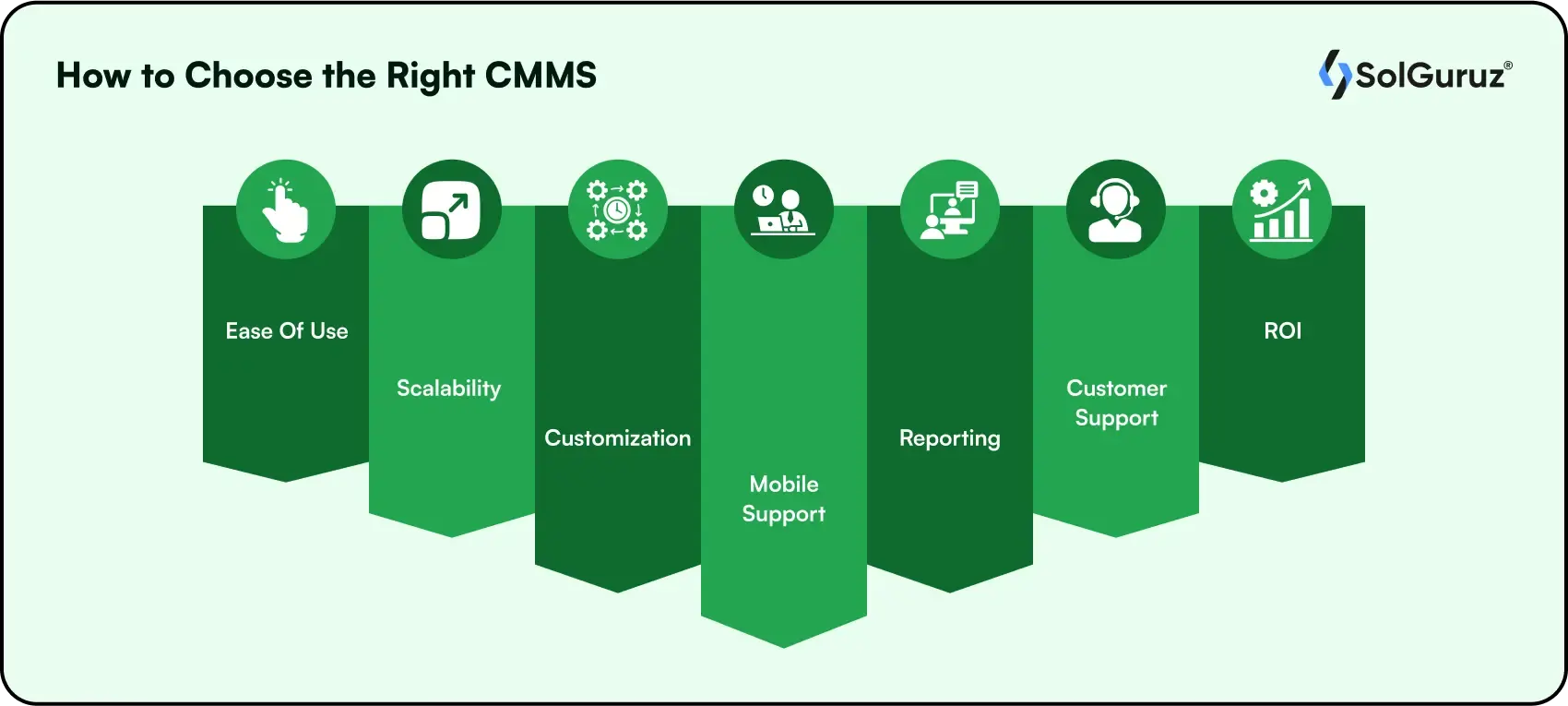
There are dozens of CMMS tools in the market. Most look the same on the surface. The difference shows up when your team starts using it. Here’s what to check before you commit:
1. Ease of Use
If technicians hate the software, they won’t use it. Look for a clean interface, quick onboarding, and a mobile-first design.
2. Scalability
Your needs will grow. Choose a system that can handle more assets, users, and sites without slowing down.
3. Customization
Every operation is different. Make sure you can set up custom fields, workflows, and reports that match how your team actually works.
4. Mobile Support
Maintenance happens on the floor, not in the office. That’s why strong mobile apps are a must. This way, technicians can update work orders, log parts, and add photos from anywhere.
5. Reporting
The point of CMMS data is to guide decisions. Check if the system provides dashboards and reports that are clear and actionable.
6. Customer Support
When the software breaks, downtime follows. Look at vendor reviews, support hours, and response times before you buy.
7. ROI
Don’t just compare price tags. Calculate what the tool can save you in reduced downtime, lower repair costs, and longer asset life. The right CMMS should pay for itself.
Final Thoughts
Think about the last time a critical machine broke down. Production stopped. People stood idle. Deadlines slipped.
All because maintenance got buried in spreadsheets and sticky notes. That’s what a CMMS prevents.
The best part: The impact of CMMS compounds as it helps in avoiding unnecessary expenses.
Working with the right CMMS software development company ensures you don’t just get off-the-shelf tools, but a tailored solution designed to grow with your operations.
If you’re exploring CMMS tools, don’t just tick feature boxes.
Ask: Will my technicians actually use this? Will it scale when I add more assets? Does it save us money in the first month, not just on paper?
FAQs
1. What exactly does a CMMS do in day-to-day work?
Imagine a technician walking the floor. A machine shows a warning. When such a thing happens, the best way to notify concerned people is via logging it into a CMMS. You can instantly create a work order, assign it to the right person, with parts and history attached. That’s the daily value: clarity and speed.
2. How is CMMS different from EAM?
If CMMS is your daily maintenance playbook, EAM is the master manual for every asset decision. It includes buying equipment as well as selling it years later. Most teams start with CMMS because uptime and efficiency are the immediate pain points.
3. Is CMMS only for large factories?
Not at all. A small facility with 10 machines can lose thousands from a single breakdown. That’s when a CMMS pays off. When the cost of missed maintenance outweighs the simplicity of spreadsheets.
4. How long does it take to get value?
Small teams can see results in a week. Larger organizations may need a phased rollout. But the real driver isn’t setup time, it’s adoption. If the system is easy for technicians, ROI shows up fast.
5. Which industries get the most out of CMMS?
Downtime is expensive, be it manufacturing, healthcare, energy, or logistics industries. But it’s not just about industries; it’s about scale. If maintenance tasks slip, you’re ready for CMMS.
6. Does CMMS work with IoT and ERP?
Yes. Picture this: a sensor detects a motor overheating. Instead of waiting for failure, the CMMS automatically creates a work order. That’s IoT integration in action. Pair it with ERP, and you connect financials with maintenance, closing the loop.
7. What is the average cost of a CMMS?
Budgets vary by scope and features. A basic MVP might start around $40,000 - $60,000, while feature-rich apps with AI, AR/VR, or integrations can cross $100,000+. The right question isn’t just cost it’s what level of user experience and scalability you’re aiming for.
8. How is CMMS different from maintenance management apps?
A maintenance app handles simple tasks like job tracking or reminders. A CMMS goes deeper - managing work orders, assets, preventive schedules, inventory, and reports. Think of it as the difference between a to-do list and a full operating system for maintenance teams.
From Insight to Action
Insights define intent. Execution defines results. Understand how we deliver with structure, collaborate through partnerships, and how our guidebooks help leaders make better product decisions.
Need a Custom CMMS Solution?
We design and build CMMS software that fits your business.

Strict NDA

Trusted by Startups & Enterprises Worldwide

Flexible Engagement Models

1 Week Risk-Free Trial
Give us a call now!

+1 (724) 577-7737


